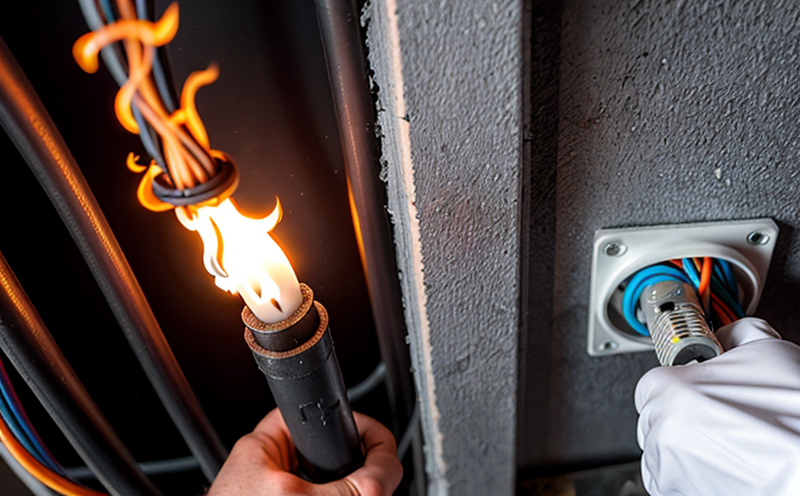Fire Resistance Testing of Data and Communication Cables
The importance of fire resistance testing in data and communication cables cannot be overstated. In today’s high-tech world, where critical infrastructure such as servers, networking equipment, and smart buildings depend on reliable and secure connections, the integrity of these cables during a fire event is paramount. Fire resistance testing ensures that the materials used in these cables can withstand the intense heat generated by fires without compromising their performance or causing further hazards.
Data and communication cables are vital for maintaining uninterrupted data flow, which is essential for both commercial operations and public safety. These cables are often installed in areas with limited accessibility during emergencies, making it crucial that they remain functional even under extreme conditions. Fire resistance testing provides peace of mind to stakeholders by validating the cable’s ability to prevent the spread of fire through insulation or shielding materials.
Testing involves exposing the cable to controlled temperatures and heat sources until a flame is generated. The performance of the cable is then evaluated based on parameters such as the time it takes for the flame to extinguish, the rate at which it propagates along the length of the cable, and the extent of damage caused to the insulation or sheathing material.
The testing process also examines how well the cable can maintain its electrical properties under fire exposure. This includes measuring voltage drop, capacitance changes, and overall resistance variations that could affect data transmission quality. Compliance with international standards such as ISO 17461, IEC 60332, or EN 50265 ensures that the tested cables meet safety requirements for use in various environments.
Fire resistance testing plays a critical role not only in enhancing product quality but also in safeguarding lives and property. By ensuring that data and communication cables can endure fire without failing catastrophically, we contribute to safer structures and infrastructure. This is particularly important in industries like telecommunications, healthcare facilities, data centers, and smart cities where continuous connectivity is essential.
It’s worth noting that the fire resistance of a cable depends on various factors including its composition, construction, and manufacturing processes. Proper testing helps manufacturers identify potential weaknesses early on so they can make necessary adjustments before products reach end-users. For instance, certain types of jacketing materials may offer better protection against flames compared to others.
Compliance with relevant standards also assures customers about the reliability of their purchases since it demonstrates adherence to recognized benchmarks set by industry experts worldwide. This fosters trust between suppliers and buyers while promoting fair competition among companies offering similar products.
Applied Standards
Data and communication cables subjected to fire resistance testing must adhere to specific standards that dictate the methods used for assessing their performance during a simulated fire scenario. Some key international standards include:
- ISO 17461:2013 - This standard provides guidance on how to conduct flame propagation tests on electric cables with rated voltages up to and including 800V AC or 1000V DC. It covers both single-core and multi-conductor cables.
- IEC 60332-1:2009 - Known as the "horizontal flame test," this standard evaluates whether a cable will continue to burn after being removed from a flame source or if it self-extinguishes quickly. It applies specifically to single-insulated or stranded bare conductors.
- EN 50265 - A European standard that specifies the requirements for fire resistance of communication cables and similar products.
These standards provide a structured approach ensuring consistent results across different laboratories conducting these tests. They help eliminate ambiguity around what constitutes adequate protection against fires, thereby promoting uniformity in quality assurance practices globally.
International Acceptance and Recognition
The acceptance of fire resistance testing for data and communication cables is widespread across many countries due to its importance in ensuring public safety. Organizations like Underwriters Laboratories (UL) and National Fire Protection Association (NFPA), based in the United States, have established stringent guidelines that must be followed by manufacturers who wish to sell their products within North American markets.
Similarly, European Union regulations require compliance with relevant standards such as those mentioned above. In Asia-Pacific regions, there are local bodies like the Chinese National Standardization Administration (SAC) which mandate adherence to certain specifications depending on specific country requirements. Globally recognized certification marks such as CE Marking indicate that a product has met all necessary criteria for fire safety according to European Union directives.
Compliance with these standards not only facilitates easier market entry but also enhances brand reputation among consumers who prioritize safety features when choosing products. It shows commitment towards producing high-quality goods capable of meeting global expectations regarding fire resistance capabilities.
Competitive Advantage and Market Impact
Firing resistance testing confers significant competitive advantages on companies specializing in data and communication cables. By demonstrating robust fire safety features, firms can differentiate themselves from competitors offering less secure alternatives.
- Increased market share: Products that pass rigorous fire resistance tests are more likely to be chosen by discerning customers seeking peace of mind regarding their investments in infrastructure.
- Better customer satisfaction: Safer products lead to higher customer satisfaction levels, fostering long-term relationships and repeat business opportunities.
- Enhanced brand reputation: Compliance with international standards enhances the overall image of a company, making it more attractive not only to existing clients but also to potential new ones looking for reliable suppliers.
The implementation of fire resistance testing also drives innovation within the industry as manufacturers strive to develop better materials and designs capable of meeting increasingly stringent requirements. This continuous improvement benefits both producers and consumers alike, creating a virtuous cycle that promotes safer and more efficient communication networks globally.





